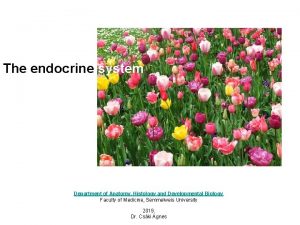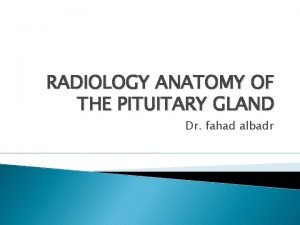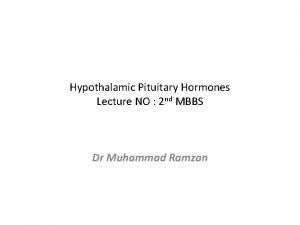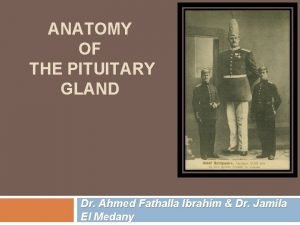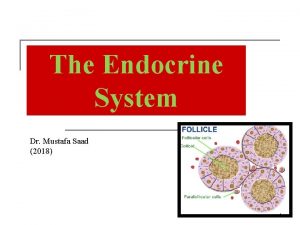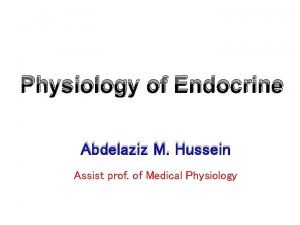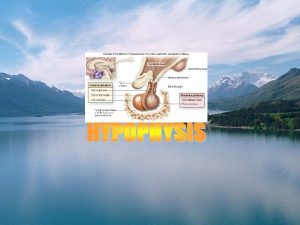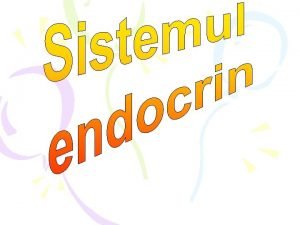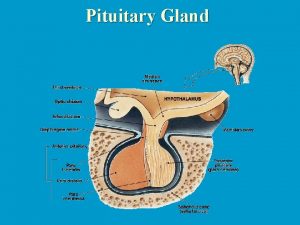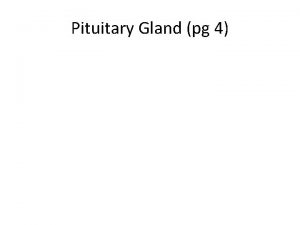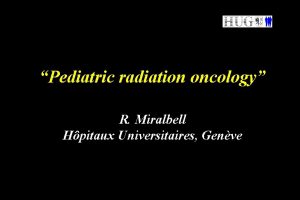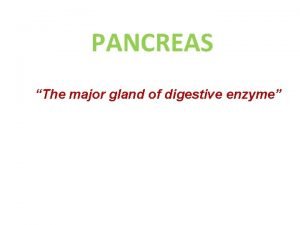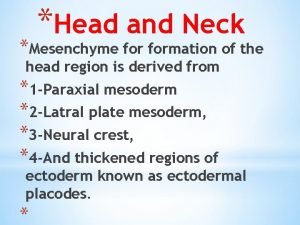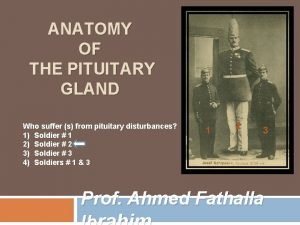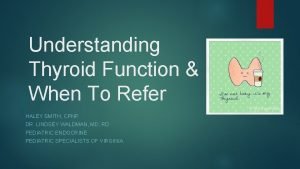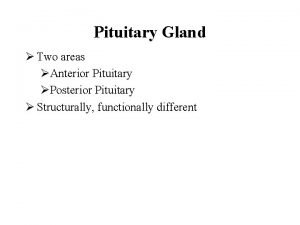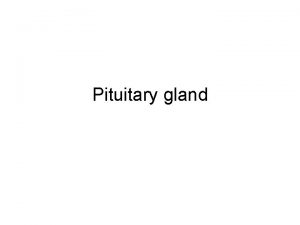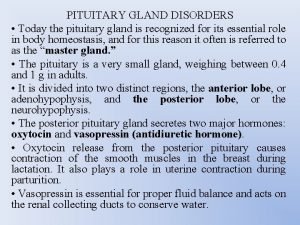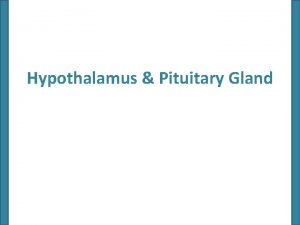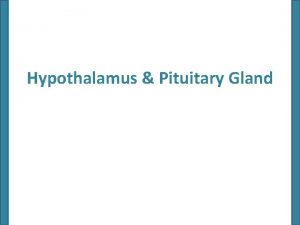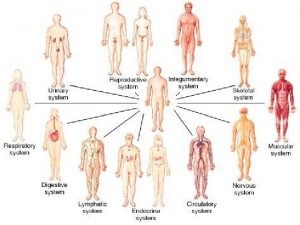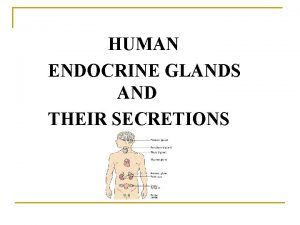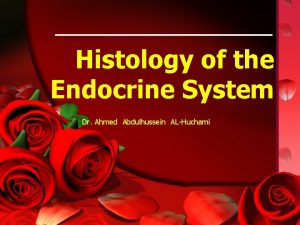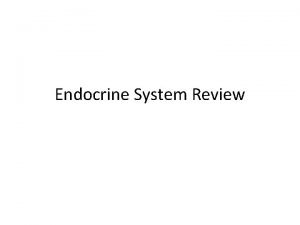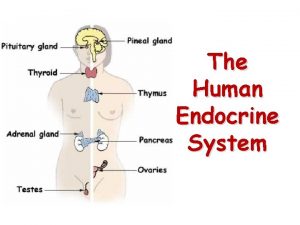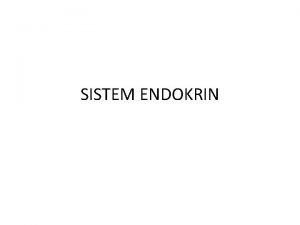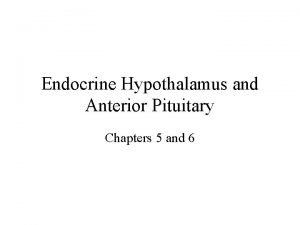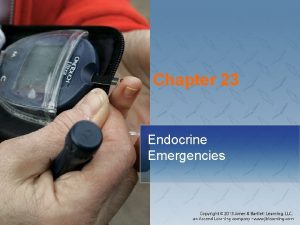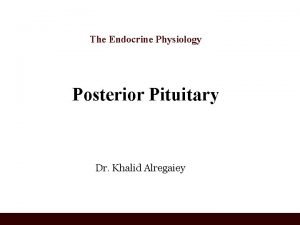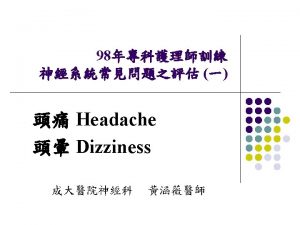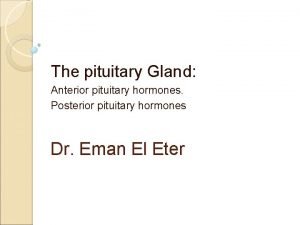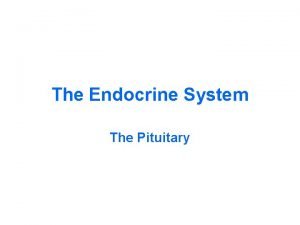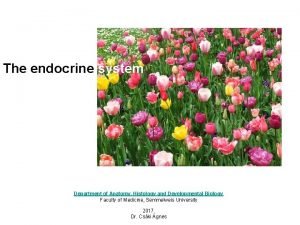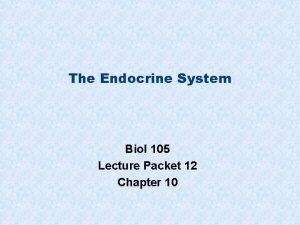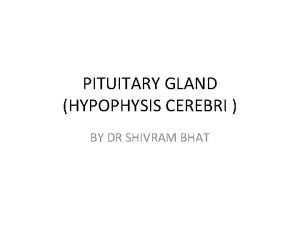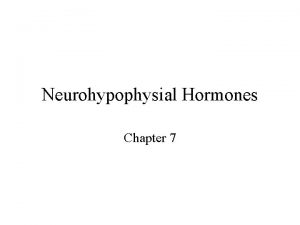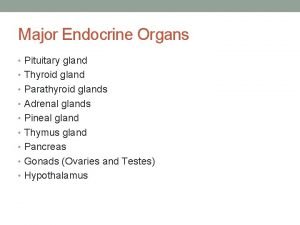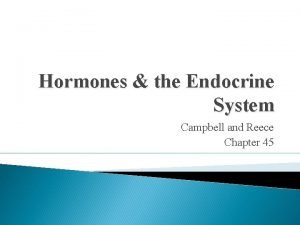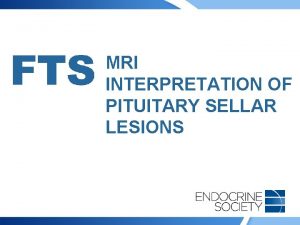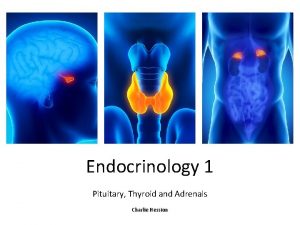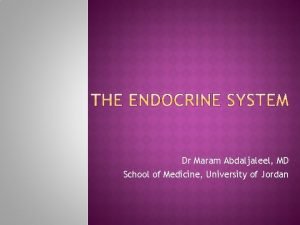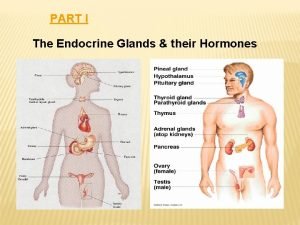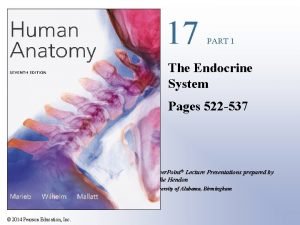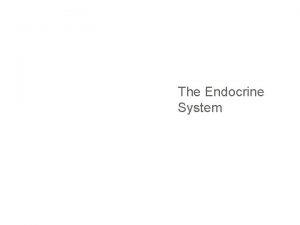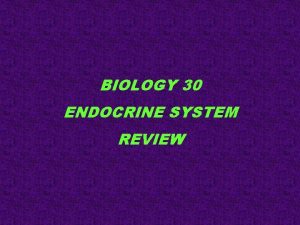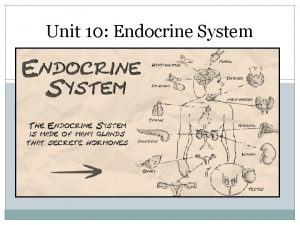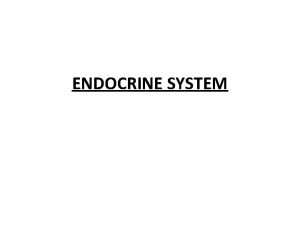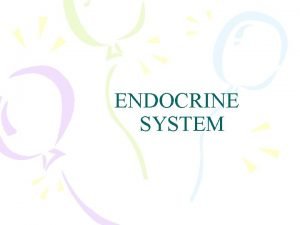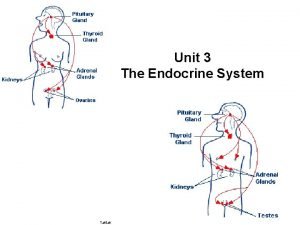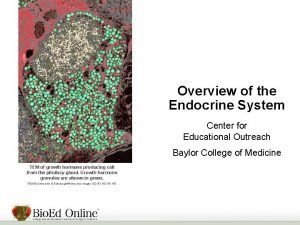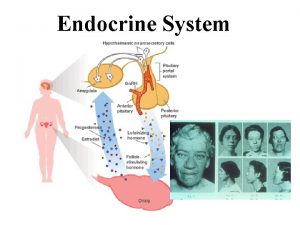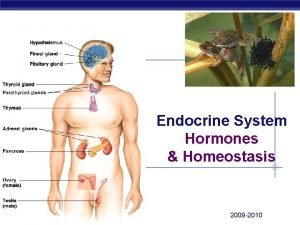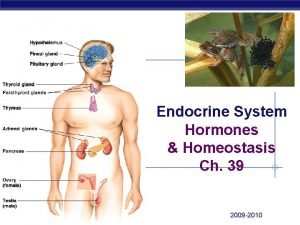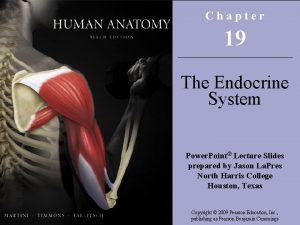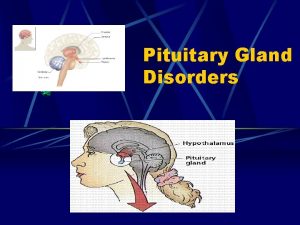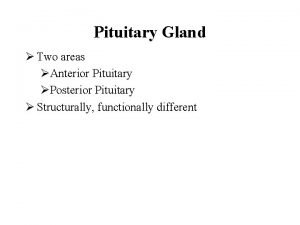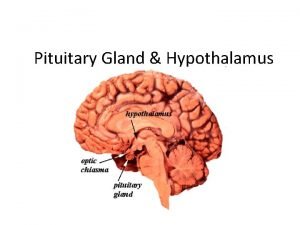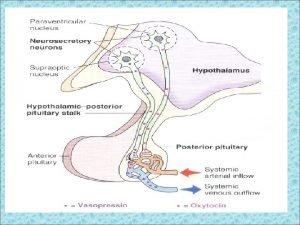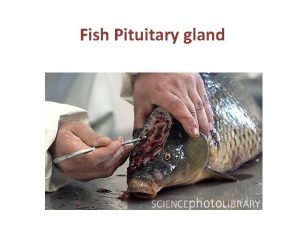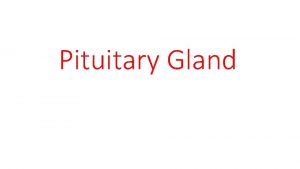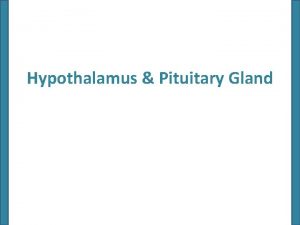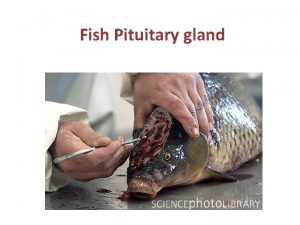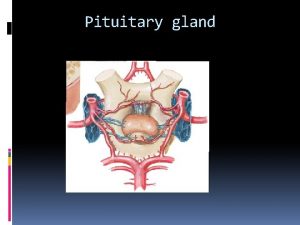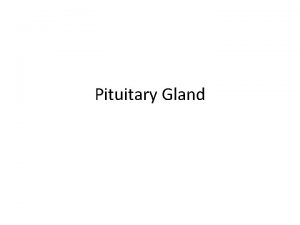Endocrine System Today Endocrine System Pituitary gland Master



























































































- Slides: 91

Endocrine System

Today Endocrine System • Pituitary gland “Master Gland” • Organs of the Endocrine system • Thyroid • Parathyroid • Adrenals • Pancreas

1. Compare the similarities between the endocrine and nervous system. 2. Compare the similarities between the Anterior Pituitary Gland the Posterior Pituitary Gland.

Copyright The Mc. Graw-Hill Companies, Inc. Permission required for reproduction or display. Introduction A. The endocrine system is made up of the cells, tissues, and organs that secrete hormones into body fluids. B. The body has two kinds of glands, exocrine (secretes products into ducts) and endocrine (secrete products into body fluids to affect target cells).

Copyright The Mc. Graw-Hill Companies, Inc. Permission required for reproduction or display. General Characteristics of the Endocrine System A. The endocrine system’s function is to • communicate with cells using chemicals called hormones. B. Endocrine glands and their hormones • regulate a number of metabolic processes within cells, and the whole body.

Copyright The Mc. Graw-Hill Companies, Inc. Permission required for reproduction or display. C. Their actions are precise, • they only affect specific target cells. D. Endocrine glands include the 1. pituitary gland, 2. thyroid gland, 3. parathyroid glands, 4. adrenal glands, 5. pancreas, and other hormone-secreting glands and tissues.



Copyright The Mc. Graw-Hill Companies, Inc. Permission required for reproduction or display. Hormone Action A. Hormones are can be divided into three groups on the basis of chemical structure: amino acid derivatives (Epinephrine, Norepinephrine, thyroid hormones, melatonin), peptide hormones ( ADH, Oxytocin, GH, Prolactin), and lipid derivatives (steroids). • Alter cellular operations by changing the identies, activities, or quantities of import enzymes and structural proteins in various target cells. • they can influence target cells even if they are present only in minute concentrations.

Copyright The Mc. Graw-Hill Companies, Inc. Permission required for reproduction or display.

Copyright The Mc. Graw-Hill Companies, Inc. Permission required for reproduction or display. C. Nonsteroid Hormones 1. Receptors in target cell membranes 2. The hormone-receptor complex (as first messenger) triggers a cascade of biological activity.

Copyright The Mc. Graw-Hill Companies, Inc. Permission required for reproduction or display. 3. The hormone-receptor complex generally activates a G protein, which then activates the enzyme adenylate cyclase that is bound to the inner cell membrane.

Copyright The Mc. Graw-Hill Companies, Inc. Permission required for reproduction or display. 4. This enzyme removes two phosphates from ATP to produce cyclic AMP (the second messenger), which in turn activates protein enzymes that activate proteins.

Copyright The Mc. Graw-Hill Companies, Inc. Permission required for reproduction or display. 5. 6. These activated proteins induce changes in the cell. Not all nonsteroid hormones use c. AMP; others use diacylglycerol (DAG) or inositol triphosphate.

Copyright The Mc. Graw-Hill Companies, Inc. Permission required for reproduction or display.


Copyright The Mc. Graw-Hill Companies, Inc. Permission required for reproduction or display. D. Prostaglandins 1. Prostaglandins are locally-produced lipids that affect the organ in which they are produced. 2. Prostaglandins produce a variety of effects: some relax smooth muscle, others contract smooth muscle, some stimulate secretion of other hormones, and others influence blood pressure and inflammation.

Copyright The Mc. Graw-Hill Companies, Inc. Permission required for reproduction or display. Control of Hormonal Secretions A. Hormone levels are very precisely regulated. B. Control Mechanisms 1. Release of hormones from the hypothalamus controls secretions of the anterior pituitary. 2. The nervous system influences certain endocrine glands directly. 3. Other glands respond directly to changes in the internal fluid composition.

Copyright The Mc. Graw-Hill Companies, Inc. Permission required for reproduction or display. C. Negative Feedback Systems 1. Commonly, negative feedback mechanisms control hormonal releases. 2. In a negative feedback system, a gland is sensitive to the concentration of the substance it regulates or which regulates it.

Copyright The Mc. Graw-Hill Companies, Inc. Permission required for reproduction or display. 3. When the concentration of the regulated substance reaches a certain level (high or low), it inhibits the gland from secreting more hormone until the concentration returns to normal.

Copyright The Mc. Graw-Hill Companies, Inc. Permission required for reproduction or display.

Copyright The Mc. Graw-Hill Companies, Inc. Permission required for reproduction or display. Location of Major Endocrine Glands

Copyright The Mc. Graw-Hill Companies, Inc. Permission required for reproduction or display. Pituitary Gland “Master Gland” A. The pituitary gland is attached to the base of the brain • has an anterior lobe (anterior pituitary) & • a posterior lobe (posterior pituitary).

Copyright The Mc. Graw-Hill Companies, Inc. Permission required for reproduction or display.


Copyright The Mc. Graw-Hill Companies, Inc. Permission required for reproduction or display. B. The brain controls the activity of the pituitary gland. 1. Releasing hormones from the hypothalamus control the secretions of the Anterior Pituitary. a. The releasing hormones are carried in the bloodstream directly to the Anterior Pituitary by hypophyseal portal veins.



Copyright The Mc. Graw-Hill Companies, Inc. Permission required for reproduction or display. 2. The Posterior Pituitary releases hormones into the bloodstream in response to nerve impulses from the hypothalamus.


Copyright The Mc. Graw-Hill Companies, Inc. Permission required for reproduction or display. C. Anterior Pituitary Hormones 1. The anterior pituitary consists mostly of epithelial tissue arranged around blood vessels and enclosed in a capsule of collagenous connective tissue. I. Growth hormone (GH) II. Prolactin (PRL) III. Thyroid-stimulating hormone (TSH) IV. Adrenocorticotropic hormone (ACTH) V. VI. Follicle-stimulating hormone (FSH) and Luteinizing hormone (LH)

Copyright The Mc. Graw-Hill Companies, Inc. Permission required for reproduction or display. 2. Growth hormone (GH) stimulates body cells to grow and reproduce; it also speeds the rate at which cells use carbohydrates and fats. a. Growth hormone-releasing hormone from the hypothalamus increases the amount of GH released, GH release-inhibiting hormone inhibits release. b. Nutritional status affects the release of GH v. Acromegaly- excess GH causes an enlargement of hands and feet, facial features

Copyright The Mc. Graw-Hill Companies, Inc. Permission required for reproduction or display. 3. Prolactin (PRL) promotes milk production following the birth of an infant. a. The effect of PRL in males is less-well understood, although it may cause a deficiency of male sex hormones. v. Prolactinoma- menstral changes, infertility, in men impotence, loss of sexual drive


Copyright The Mc. Graw-Hill Companies, Inc. Permission required for reproduction or display. 4. Thyroid-stimulating hormone (TSH) controls the secretion of hormones from the thyroid gland. a. Thyrotropin-releasing hormone (TRH) from the hypothalamus regulates the release of TSH. c. As blood concentrations of thyroid hormones increases, secretions of TRH and TSH decrease. v. Hypothyroidism (Hashimoto’s disease, Goiter) and Hyperthyroidism (Graves’ disease)

Copyright The Mc. Graw-Hill Companies, Inc. Permission required for reproduction or display. 5. Adrenocorticotropic hormone (ACTH) controls the secretion of hormones from the adrenal cortex. a. It is regulated by corticotropinreleasing hormone from the hypothalamus, and stress can also increase its release. v. Adrenal gland diseases- glucocorticoids (blood sugar levels and metabolism of proteins and fats), Mineralocorticoids (body’s electrolyte level), and Androgens (sex hormones)



Copyright The Mc. Graw-Hill Companies, Inc. Permission required for reproduction or display. 6. Follicle-stimulating hormone (FSH) and luteinizing hormine (LH) are gonadotropins affecting the male and female sex organs. v. Infertility

Copyright The Mc. Graw-Hill Companies, Inc. Permission required for reproduction or display. D. Posterior Pituitary Hormones 1. The posterior lobe consists of nerve fibers and neuroglial cells that support nerve fibers arising in the hypothalamus. 2. Neurons in the hypothalamus produce antidiuretic hormone and oxytocin, which are stored in the posterior pituitary.


Copyright The Mc. Graw-Hill Companies, Inc. Permission required for reproduction or display. 3. Antidiuretic hormone (ADH) produces its effect by causing the kidneys to conserve water. a. The hypothalamus regulates the secretion of ADH based on the amount of water in body fluids. v Diabetes Insipidus- insufficient ADH loss of water balance

Copyright The Mc. Graw-Hill Companies, Inc. Permission required for reproduction or display. 4. Oxytocin plays a role in childbirth by contracting muscles in the uterine wall, and in milk-letdown by forcing milk into ducts from the milk glands. a. Stretching of the uterus in the latter stages of pregnancy stimulates release of oxytocin. b. Suckling of an infant at the breast stimulates release of oxytocin after childbirth. v. Inducing Labor- synthetic oxytocin


Glands (Hormone Target Tissue) • • Thyroid Parathyroid Adrenal Pancrease

Copyright The Mc. Graw-Hill Companies, Inc. Permission required for reproduction or display. Thyroid Gland A. The thyroid gland is located below the larynx and consists of two broad lobes connected by an isthmus. B. Structure of the Gland 1. The thyroid consists of secretory parts called follicles filled with hormonestoring colloid.

Copyright The Mc. Graw-Hill Companies, Inc. Permission required for reproduction or display.



Copyright The Mc. Graw-Hill Companies, Inc. Permission required for reproduction or display. C. Thyroid Hormones 1. The follicular cells produce two iodinecontaining hormones, thyroxine (T 4) (tetraiodothyronine) and triiodothyronine (T 3), that together regulate energy metabolism.

Copyright The Mc. Graw-Hill Companies, Inc. Permission required for reproduction or display. a. These two hormones increase the rate at which cells release energy from carbohydrates, enhance protein synthesis, and stimulate the breakdown and mobilization of lipids.

Copyright The Mc. Graw-Hill Companies, Inc. Permission required for reproduction or display. b. c. These hormones are essential for normal growth and development. The hypothalamus and pituitary gland control release of thyroid hormones.

Copyright The Mc. Graw-Hill Companies, Inc. Permission required for reproduction or display. 2. Extrafollicular cells of the thyroid secrete calcitonin, which lowers blood levels of calcium and phosphate ions when they are too high. a. Calcitonin increases the rate at which calcium is stored in bones and excreted in the urine. b. Calcitonin secretion is regulated by negative feedback involving blood concentrations of calcium.

Copyright The Mc. Graw-Hill Companies, Inc. Permission required for reproduction or display. Parathyroid Glands A. The four, tiny parathyroids are located on the posterior of the thyroid. B. Structure of the Glands 1. Parathyroid glands consist of tightly packed secretory cells covered by a thin capsule of connective tissue.

Copyright The Mc. Graw-Hill Companies, Inc. Permission required for reproduction or display.

Copyright The Mc. Graw-Hill Companies, Inc. Permission required for reproduction or display. C. Parathyroid Hormone 1. Parathyroid hormone (PTH) increases blood calcium ion concentration and decreases phosphate ion concentration. 2. PTH stimulates bone resorption by osteoclasts, which releases calcium into the blood. 3. PTH also influences the kidneys to conserve calcium and causes increased absorption of calcium in the intestines.

Copyright The Mc. Graw-Hill Companies, Inc. Permission required for reproduction or display.

Copyright The Mc. Graw-Hill Companies, Inc. Permission required for reproduction or display. 4. A negative feedback mechanism involving blood calcium levels regulates release of PTH. D. Calcitonin and PTH exert opposite effects in regulating calcium ion levels in the blood.

Copyright The Mc. Graw-Hill Companies, Inc. Permission required for reproduction or display.



Next • • Adrenals Pancreas Pineal Gland Thymus Reproductive Digestive glands Stress and Health

Copyright The Mc. Graw-Hill Companies, Inc. Permission required for reproduction or display. Adrenal Glands A. The adrenal glands sit atop the kidneys enclosed in a layer of fat.

Copyright The Mc. Graw-Hill Companies, Inc. Permission required for reproduction or display.


Copyright The Mc. Graw-Hill Companies, Inc. Permission required for reproduction or display. C. Hormones of the Adrenal Medulla 1. The adrenal medulla secretes epinephrine and norepinephrine into the blood stream. 2. The effects of these hormones resemble those of the sympathetic division neurotransmitters of the same name, except that they last up to 10 times longer when they are secreted as hormones.

Copyright The Mc. Graw-Hill Companies, Inc. Permission required for reproduction or display. 3. 4. The are used in times of stress and for “fight or flight. ” Release of medullary hormones is regulated by nervous impulses from the central nervous system.

Copyright The Mc. Graw-Hill Companies, Inc. Permission required for reproduction or display. D. Hormones of the Adrenal Cortex 1. The cells of the adrenal cortex produce over 30 different steroids, some of which are vital to survival, the most important of which are aldosterone (mineralocorticoid), cortisol (Glucocorticoid), and the sex hormones (Androgens).

Copyright The Mc. Graw-Hill Companies, Inc. Permission required for reproduction or display. 2. Aldosterone a. Aldosterone, a mineralocorticoid, causes the kidneys to conserve sodium ions and thus water, and to excrete potassium ions. b. Aldosterone is secreted in response to decreasing blood volume and blood pressure as a result of changes in the kidney.

Copyright The Mc. Graw-Hill Companies, Inc. Permission required for reproduction or display. 3. Cortisol a. Cortisol, a glucocorticoid, influences the metabolism of glucose, protein, and fat in response to conditions that stress the body and require a greater supply of energy in the bloodstream. v. Cushing’s Syndrome- excess cortisol, longer healing time, face becomes puffy, fatigue, high blood pressure, hyperglycemic

Copyright The Mc. Graw-Hill Companies, Inc. Permission required for reproduction or display.

Copyright The Mc. Graw-Hill Companies, Inc. Permission required for reproduction or display. b. c. A negative feedback mechanism involving CRH from the hypothalamus and ACTH from the anterior pituitary controls the release of cortisol. Stress, injury, or disease can also trigger increased release of cortisol.

Copyright The Mc. Graw-Hill Companies, Inc. Permission required for reproduction or display.

Copyright The Mc. Graw-Hill Companies, Inc. Permission required for reproduction or display. 4. Adrenal Sex Hormones a. Sex hormones, produced in the inner zone, are mostly of the male type, but can be converted to female hormones in the skin, liver, and adipose tissues. b. These hormones supplement those released by the gonads and may stimulate early development of reproductive organs.

Copyright The Mc. Graw-Hill Companies, Inc. Permission required for reproduction or display. Pancreas A. The pancreas secretes hormones as an endocrine gland, and digestive juices to the digestive tract as an exocrine gland.

Copyright The Mc. Graw-Hill Companies, Inc. Permission required for reproduction or display. B. Structure of the Gland 1. The pancreas is an elongated organ posterior to the stomach. 2. Its endocrine portions are the islets of Langerhans that include two cell types-alpha cells that secrete glucagon, and beta cells that secrete insulin.

Copyright The Mc. Graw-Hill Companies, Inc. Permission required for reproduction or display. C. Hormones of the Islets of Langerhans 1. Glucagon increases the blood levels of glucose by stimulating the breakdown of glycogen and the conversion of noncarbohydrates into glucose. a. The release of glucagon is controlled by a negative feedback system involving low blood glucose levels.

Copyright The Mc. Graw-Hill Companies, Inc. Permission required for reproduction or display. 2. Insulin decreases the blood levels of glucose by stimulating the liver to form glycogen, increasing protein synthesis, and stimulating adipose cells to store fat. a. The release of insulin is controlled by a negative feedback system involving high blood glucose levels.

Copyright The Mc. Graw-Hill Companies, Inc. Permission required for reproduction or display. 3. Insulin and glucagon coordinate to maintain a relatively stable blood glucose concentration.


Copyright The Mc. Graw-Hill Companies, Inc. Permission required for reproduction or display.

Copyright The Mc. Graw-Hill Companies, Inc. Permission required for reproduction or display. Other Endocrine Glands A. Pineal Gland 1. The pineal gland, near the upper portion of the thalamus, secretes melatonin, which is involved in the regulation of circadian rhythms of the body.

Copyright The Mc. Graw-Hill Companies, Inc. Permission required for reproduction or display. B. Thymus Gland 1. The thymus gland, lying between the lungs under the sternum, secretes thymosins that affect production and differentiation of T lymphocytes that are important in immunity.

Copyright The Mc. Graw-Hill Companies, Inc. Permission required for reproduction or display. C. Reproductive Glands 1. The ovaries produce estrogen and progesterone. 2. The placenta produces estrogen, progesterone, and a gonadotropin. 3. The testes produce testosterone.

Copyright The Mc. Graw-Hill Companies, Inc. Permission required for reproduction or display. D. Digestive Glands 1. The digestive glands secrete hormones associated with the processes of digestion. E. Other Hormone Producing Organs 1. The heart secretes atrial natriuretic peptide affecting sodium and the kidneys secrete erythropoietin for blood cell production.

Copyright The Mc. Graw-Hill Companies, Inc. Permission required for reproduction or display. Stress and Health A. Factors that serve as stressors to the body produce stress and threaten homeostasis.

Copyright The Mc. Graw-Hill Companies, Inc. Permission required for reproduction or display. B. Types of Stress 1. Stress may be physical, psychological, or some combination of the two.

Copyright The Mc. Graw-Hill Companies, Inc. Permission required for reproduction or display. 2. 3. Physical stress threatens the survival of tissues, such as extreme cold, prolonged exercise, or infections. Psychological stress results from real or perceived dangers, and includes feelings of anger, depression, fear, and grief; sometimes even pleasant stimuli cause stress.

Copyright The Mc. Graw-Hill Companies, Inc. Permission required for reproduction or display. C. Response to Stress 1. Responses to stress are designed to maintain homeostasis. 2. The hypothalamus controls the general stress syndrome, which involves increased sympathetic activity and increased secretion of cortisol, glucagon, growth hormone, and antidiuretic hormone.


 Pituitary gland and pineal gland spiritual
Pituitary gland and pineal gland spiritual Thyoid gland
Thyoid gland Pituitary gland inferior view
Pituitary gland inferior view Nerve supply of pituitary gland
Nerve supply of pituitary gland Pituitary gland division
Pituitary gland division Pituitary gland nerve supply
Pituitary gland nerve supply Hypophyseal fossa and pituitary gland
Hypophyseal fossa and pituitary gland Diaphragm sella
Diaphragm sella Acromegaly before and after
Acromegaly before and after Hypophyseal fossa and pituitary gland
Hypophyseal fossa and pituitary gland Hypersecretion of prolactin
Hypersecretion of prolactin Htpothalamus
Htpothalamus Blood supply of pituitary gland
Blood supply of pituitary gland Hormones secreted by adenohypophysis
Hormones secreted by adenohypophysis Pituitary gland hormones
Pituitary gland hormones Pituitary gland
Pituitary gland Posterior abdominal wall nerves
Posterior abdominal wall nerves Pituitary gland
Pituitary gland Subdivision of pituitary gland
Subdivision of pituitary gland Pituitary gland thyroid
Pituitary gland thyroid Anterior pituitary gland
Anterior pituitary gland Embryonic origin of pituitary gland
Embryonic origin of pituitary gland Pituitary gland disorders
Pituitary gland disorders Pituitary gland
Pituitary gland Hypothalamus and pituitary gland connection
Hypothalamus and pituitary gland connection Human body systems images
Human body systems images Triple f gland for flight fright and fight is
Triple f gland for flight fright and fight is Dictalie
Dictalie Colloid anatomy
Colloid anatomy What is the name
What is the name Anterior pituitary hormones
Anterior pituitary hormones Estrogen effect
Estrogen effect Exocrine vs endocrine
Exocrine vs endocrine For todays meeting
For todays meeting Todaysclass
Todaysclass Today meeting or today's meeting
Today meeting or today's meeting Fingerprint galton details
Fingerprint galton details Today's lesson or today lesson
Today's lesson or today lesson Today's lesson or today lesson
Today's lesson or today lesson Hypothalamic pituitary portal system
Hypothalamic pituitary portal system Endocrine system and reproductive system
Endocrine system and reproductive system Endocrine system vs nervous system
Endocrine system vs nervous system Lympathic
Lympathic Nervous system vs endocrine system venn diagram
Nervous system vs endocrine system venn diagram Endocrine system and nervous system
Endocrine system and nervous system Difference between anterior and posterior pituitary
Difference between anterior and posterior pituitary Pituitary
Pituitary Posterior pituitary hormones
Posterior pituitary hormones Epley maneuver
Epley maneuver Cl channel
Cl channel Positive feedback mechanism
Positive feedback mechanism Staining
Staining Parathyroid gland chief cell
Parathyroid gland chief cell Pituitary dwarfism
Pituitary dwarfism Pituitary hormones and their targets
Pituitary hormones and their targets Pituitary and optic chiasm
Pituitary and optic chiasm Difference between anterior and posterior pituitary
Difference between anterior and posterior pituitary Anterior pituitary
Anterior pituitary Anterior pituitary hormones
Anterior pituitary hormones Pituitary adenoma
Pituitary adenoma Propothiouracil
Propothiouracil Anterior pituitary
Anterior pituitary Endocrine system organs
Endocrine system organs Adenohypophysis
Adenohypophysis Sympathetic nervous system
Sympathetic nervous system Comparison of endocrine and nervous system
Comparison of endocrine and nervous system Endocrine molecules
Endocrine molecules Facts about the endocrine system
Facts about the endocrine system External anatomy of a rat
External anatomy of a rat Oxication
Oxication Metabolic action of growth hormone
Metabolic action of growth hormone Are endocrine glands ductless
Are endocrine glands ductless 7:13 endocrine system
7:13 endocrine system Mammillary body
Mammillary body Humoral stimulus
Humoral stimulus Chapter 11 endocrine system
Chapter 11 endocrine system Biology 30 endocrine system
Biology 30 endocrine system Chromaffin cells
Chromaffin cells Endocrine system analogy
Endocrine system analogy Introduction of endocrine system
Introduction of endocrine system Endocrine system abbreviations
Endocrine system abbreviations T4.taktak
T4.taktak Endocrine system
Endocrine system Endocrine system
Endocrine system Baylor
Baylor Glands of the endocrine system
Glands of the endocrine system Endocrine system
Endocrine system Unit 6 human development lesson 1 pregnancy
Unit 6 human development lesson 1 pregnancy Endocrine system regents questions
Endocrine system regents questions Endocrine system regents questions
Endocrine system regents questions Chapter 45 hormones and the endocrine system
Chapter 45 hormones and the endocrine system Endocrine tissues
Endocrine tissues


